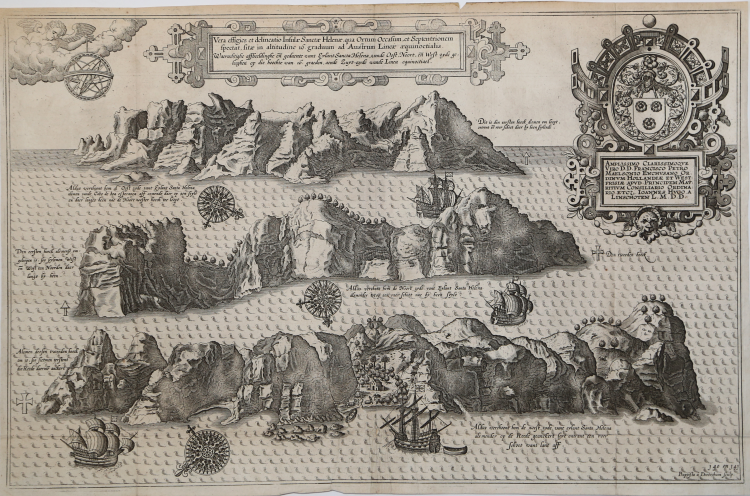



| Reference: | ms6380 |
| Author | Jan Huygen van LINSCHOTEN |
| Year: | 1596 ca. |
| Zone: | Saint Helena |
| Printed: | Amsterdam |
| Measures: | 480 x 310 mm |


| Reference: | ms6380 |
| Author | Jan Huygen van LINSCHOTEN |
| Year: | 1596 ca. |
| Zone: | Saint Helena |
| Printed: | Amsterdam |
| Measures: | 480 x 310 mm |
St Helena was an important early re-supply point for the Portuguese from the late 1400s, particularly on their return voyages from Asia. This map appeared in Linschoten's book.
The map shows a detailed view of the island: the town, landing places, etc. Ships at anchor in the harbor fly the Portuguese standard. Three elaborate cartouches dominate the upper part of the map, one being the arms of Portugal. A large compass rose is on the bottom left of the map. The engraver for this map was Baptista van Doetechum.
References: Schilder, Gunter, Monumenta Cartographica Neerlandica, vol VII; Tooley, Guide to Maps of Africa, p. 67.
|
Schilder, Gunter, Monumenta Cartographica Neerlandica, vol VII; Tooley, Guide to Maps of Africa, p. 67.
|
Jan Huygen van LINSCHOTEN (Haarlem, ca. 1563 - Enkhuizen 1611)
|
Dutch Protestant merchant, traveller and historian and geographer. He spent five years in Goa. Back in Holland, Van Linschoten sold his travel report to the Amsterdam publisher Cornelis Claesz, who published it in 1596 in a book that was beautifully illustrated with prints and maps. The Itinerario is more than a travel report: next to the account of his wanderings in the waters of the Azores, Portugal and the islands of what is now Indonesia, two further texts by Van Linschoten have been included in the volume. These are the Beschryvinghe van de gantsche custe van Guinea (Description of the entire coast of Guinee) and the Reys-gheschrift vande navigatien der Portugaloysers in Orienten (travel report on the navigations of the Portuguese in the East). The significance of this first Dutch compilation on India is primarily to be found in the valuable sailing instructions it contains: nautical data on currents, depths, islands and sandbanks, information sea captains could not do without if they wanted to navigate safely.
|
|
Schilder, Gunter, Monumenta Cartographica Neerlandica, vol VII; Tooley, Guide to Maps of Africa, p. 67.
|
Jan Huygen van LINSCHOTEN (Haarlem, ca. 1563 - Enkhuizen 1611)
|
Dutch Protestant merchant, traveller and historian and geographer. He spent five years in Goa. Back in Holland, Van Linschoten sold his travel report to the Amsterdam publisher Cornelis Claesz, who published it in 1596 in a book that was beautifully illustrated with prints and maps. The Itinerario is more than a travel report: next to the account of his wanderings in the waters of the Azores, Portugal and the islands of what is now Indonesia, two further texts by Van Linschoten have been included in the volume. These are the Beschryvinghe van de gantsche custe van Guinea (Description of the entire coast of Guinee) and the Reys-gheschrift vande navigatien der Portugaloysers in Orienten (travel report on the navigations of the Portuguese in the East). The significance of this first Dutch compilation on India is primarily to be found in the valuable sailing instructions it contains: nautical data on currents, depths, islands and sandbanks, information sea captains could not do without if they wanted to navigate safely.
|